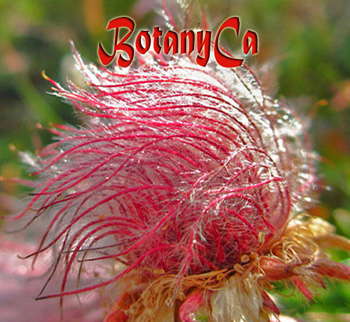Friday’s Clematis seed – or is it a fruit?
Of course it is a fruit. However, for practical reasons, we all call them seeds or seed-heads when referring to the whole fruiting aggregate.

Clematis hexapetala fruits and the actual seeds
The Clematis fruit is an achene with the former styles of the flowers remaining attached. Simple definition of an achene: a dry, one-seeded fruit that does not open to release the seed (the seed is not adherent to the fruit wall).
The fruit coat (pericarp) can become quite hard when ripe reason why it is difficult to say if there are any or good seeds inside.
The former flower styles, usually called ‘tails’, become fluffy toward maturity, an adaptation to wind dispersal, and contribute to the ornamental aspect of Clematis plants in the fall; usually they are white or rusty/brown in color. They can develop even when the pollination fails, so always pay attention if there are fruits at the end of the ‘tails’.
Our main interest is in fact how the type of fruit (or seed) may influence the germination.
The fluffy tails, do not influence the germination in any way; removing them makes sense just for the easiness of sowing (same for Pulsatilla).
Regarding the germination per se, various websites copy and paste one after another relentlessly that “Clematis seeds may take up to three years to germinate” and so on…without referring to certain species. There are a LOT of Clematis species (not to mention hybrids).
In my experience, many Clematis species will germinate after a cold/moist stratification period, i.e. sowing in late fall/winter outdoors; usually they germinate in the next spring after sowing, maybe not 100% but one doesn’t need 15 seedlings to grow one Clematis.
My opinion is that because we are sowing the fruits and do not have a visual check of the actual seeds, germination failures are mostly due to bad seeds or no seeds at all inside the fruits. This is valid as well for other species when we actually sow whole fruits instead of seeds.
There are also reports of some Clematis species germinating at warm (i.e. room temperature) which is true. I have only germinated the weedy C. tangutica this way, so I cannot confirm which species are actually warm germinators because I usually sow them in late fall.
Sometimes even ‘warm germinators’ need a short cold/moist stratification in order for the fruit coat to break down and allow water imbibition (without it the germination cannot be initiated).
Because the seed can be removed from the fruit (with patience), I also tried a described method of germinating the actual seeds in water (the ‘nude’ method); it didn’t work for me. Of course, there are many species of Clematis and I only tried a few. In any case, the whole procedure was a complete waste of time.
After many years of sowing, I remain adept of the classic method of sowing in late fall/early winter outdoors for all species; with the exception of well-known warm germinators, which are to be sown in the spring.
It has countless benefits in a cold climate like ours, so this is what I recommend including for sowing Clematis seeds; or fruits, if you want to be botanically correct.
The Clematis fruits are gradually maturing in the fall; the collection is on-going for Clematis glaucophylla and Clematis hexapetala; Clematis integrifolia is getting there, while Clematis viorna still has a bit to go. Hopefully by the time all seeds are collected, Canada Post employees decide to get back to work!
PS. You may find various germination tests and recommendations when googling for ‘Clematis germination’. The downside of most is that there is no certainty the species used in trials were true to name (seeds received from seeds exchanges are notoriously something else, plus Clematis species hybridize easily, both in the wild and in the garden). Then, in many cases, only a very small number of seeds/samples are used. We cannot generalize results after germinating 10-15 seeds.











